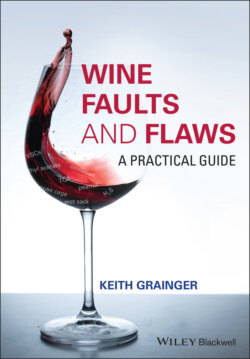Читать книгу Wine Faults and Flaws - Keith Grainger - Страница 19
1.7 Distinguishing Between Faults and Flaws
ОглавлениеIn a tasting assessment, the condition of a wine may be described as
Fault‐free (sound);
Flawed (showing minor defects);
Faulty (showing one or more serious defects).
As stated, the use of the word ‘fault’ should be reserved for major defects, including those off‐odours and off‐flavours that have a significant organoleptic impact upon a wine, or for compounds that may cause accelerated deterioration, or are harmful to human health. Where the impact is minor, including defects that result in a reduction of typicality (the word tipicité is often used amongst wine lovers and critics), or a modest reduction in quality or ageing potential the term ‘flaw’ is generally more appropriate, although some authors do regard a lack of typicality of style as a fault [14]. The level, or concentration, of causal compounds is obviously key here, but whilst the physical level is generally relatively easy to quantify by laboratory analysis, the sensory impact upon wines of differing styles and aroma and flavour matrices may be less easy to qualify: much will depend upon the style and matrix of the wine. So the boundaries between faulty, flawed, and ‘in good condition’ may, on occasions, be somewhat blurred. However, there are some compounds which, even if present at a low level, cause a such a reduction in organoleptic attributes and a loss in quality, that affected wines must always be regarded a faulty. TCA and other haloanisoles (see Chapter 3) are classic examples.
Whilst there is little doubt that a wine contaminated from an external source should always be regarded as faulty, the internally produced ‘off’‐aromas and flavours may be subject to dissent as to the concentration at which they become unacceptable and are considered to be flaws or faults. When tasting a wine, the judgments made are, to a large degree, subjective. Individuals have varying sensitivities, responses and reactions to aromas, odours and flavour compounds based on their culture and education [15], experience, and age [14]. Members of a panel of professional tasters and critics may be unanimous in their judgements when assessing a wine or there may, on occasions, be out and out dissent. There can also be disagreement between professionals and consumers as to what constitutes a fault or flaw, for example, the acceptability or otherwise of sediments. Precipitated crystals of potassium bi‐tartrate or calcium tartrate are sometimes found in the bottom of wine bottles and, of course, these will often appear in glasses of wines when poured. They are most likely in high acidity wines from cool climates, but can appear in reds too. The crystals are harmless and have no negative organoleptic impact, but to the consumer they may be cause for concern and even rejection of the bottles in question. Accordingly, although many industry professionals are unconcerned by tartrates, some do consider them to be an ‘appearance’ fault (see Chapter 15).
